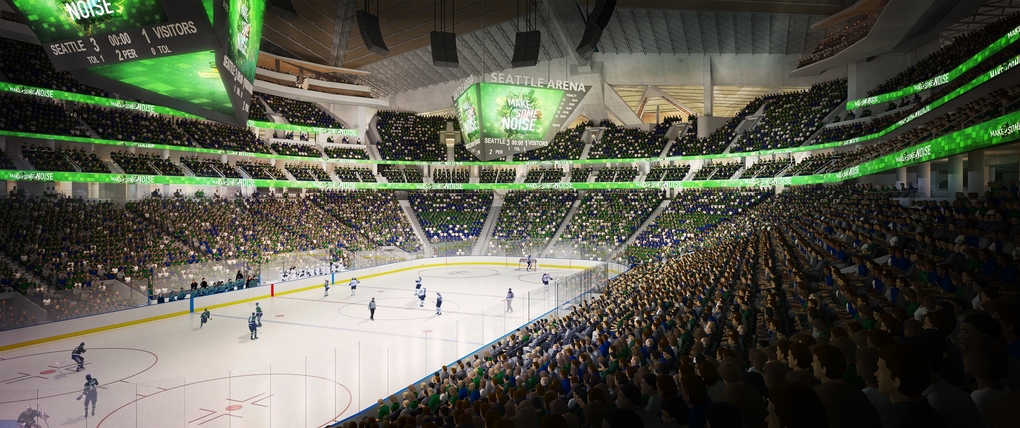On Monday, December 4, by a 7-1 vote, the Seattle City Council approved a memorandum of understanding for a $600 million renovation of KeyArena. “One small step for @NHLtoSeattle,” tweeted KCPQ Sports Director Aaron Levine, reporting on scene, “one giant leap for the Monorail.” Levine’s point is well agreed upon: The upcoming renovation, proposed by Oak View Group, is expected to clear the way for the NHL to announce a team in Seattle, followed by the potential return of the NBA to the area.
The Monorail — “the world’s first full-scale rapid-transit system,” with its two mile-a-minute trains on a 1.2-mile track — opened on March 24, 1962, a month ahead of the Seattle World’s Fair. It was the first World’s Fair in the United States in over two decades, a six-month exposition, and Seattle was ready, with the Monorail providing ease of transportation.
From April 21-October 21, 1962, the world was introduced to the Space Needle, an observatory and restaurant 600 feet above the city, now a signature part of the skyline; the Spacearium, which offered “the sensation of soaring through space in a rocket ship”; and the Bubbleator which was, yes, a bubble elevator with a 100-person capacity. It was located inside the brand-new Washington State Pavilion, where families were invited to tour The World of Tomorrow. Admission to the World’s Fair cost $2 for adults, $1 for kids.
When the World’s Fair concluded, its venues were repurposed and renamed. The exposition’s site became Seattle Center. The United States Science Pavilion, designed by architect Minoru Yamasaki, became the Pacific Science Center. The Washington State Pavilion, designed by Paul Thiry, became the Washington State Coliseum. The Coliseum was put to use, beginning with Seattle University men’s basketball.
The Seattle Chieftains (now Redhawks) were well regarded in the men’s college basketball landscape. In 1952, they had knocked off the famed Harlem Globetrotters. Six years later, featuring the talents of future Hall of Famer Elgin Baylor, they advanced to the National Championship before falling to perennial power Kentucky. In 1964, Seattle made it as far as the regional semi-final before bowing to another blue-blood, UCLA.
1964 was also the Chieftains’ first season playing home games at the Washington State Coliseum, now renamed the Seattle Center Coliseum. The team included 6–7 forward John Tresvant, hailing from the same school as Baylor, Spingarn High School in the District of Columbia. (Tresvant went on to play 559 games in the NBA.) Subsequent seasons at the Coliseum saw more future NBA players: Tom Workman, Plummer Lott, Rod Derline, Frank Oleynick, Clint Richardson and Jawann Oldham.
On March 5, 1966, Workman, Lott and the Chieftains hosted the Texas Western Miners at a packed Coliseum. The lead changed hands 19 times before a Workman jumper with 53 seconds to play handed the Miners their first loss of the year, 74-72. It was Texas Western’s final regular season game – and their only loss of the year. Two weeks later, Don Haskins’s team attained the national championship, starting an all-black lineup against Adolph Rupp’s all-white Kentucky Wildcats and triumphing, 72-65.
At the end of the 1966 calendar year, Seattle had another team to cheer about. The NBA awarded the city an expansion franchise on December 20. Founding owners Eugene Klein and Sam Schulman footed the $1.75 million price tag; the Los Angeles businessmen had also purchased the San Diego Chargers together. The team was called the SuperSonics, inspired by Boeing, becoming Seattle’s first entry into the country’s major sports leagues. (The ownership duo later split, with Schulman retaining Seattle.)
In their first season in existence, the SuperSonics finished 23-59, though there were silver linings. Over 200,000 fans attended the games at the Seattle Center Coliseum. Walt Hazzard, a third-year man out of UCLA, was the early standout, averaging 24 points per game and earning an All-Star nod. He was accompanied on the roster by top rookies Al Tucker and Bob Rule; former Seattle U. standout Plummer Lott in his rookie year; and future NBA coach and executive Rod Thorn.
The Coliseum attendance soon began to soar, aided by Lenny Wilkens. Wilkens had been acquired from St. Louis in a straight-up All-Star for All-Star trade for Hazzard. Hazzard never made it to another All-Star Game. Meanwhile, Wilkens – a future Hall of Famer as both a player and a coach – earned All-Star nods in each of his first three seasons in Seattle. Wilkens was installed as player-coach entering the 1969-1970 season and directed the franchise to its first season above .500 two years later, a 47-35 finish. The Coliseum was rocking: 444,302 showed up to cheer on their ‘Sonics, an average of 11,107 per game. Only the New York Knicks and the Los Angeles Lakers boasted larger crowds.
In 1973, Celtics icon Bill Russell returned from retirement to take over as the team’s head coach and general manager. It was that same season that the Coliseum hosted its one and only NBA All-Star Game to date. With former Chieftain Elgin Baylor joining Pat Summerall and Hot Rod Hundley on TV commentary, lone SuperSonics All-Star Spencer Haywood scored 23 points and collected 11 rebounds, helping the West to a 134-123 victory.
Russell lasted four years in Seattle, leading the SuperSonics to their first two playoff berths and back-to-back Western Conference semi-finals. He chose his cousin, Bob Hopkins, to replace him, an ill-fated decision. Hopkins’s ’Sonics lost their first game on the road by 32 points, 116-84 to Golden State. When Seattle’s record slipped to 5-17, general manager Zollie Volchok reassigned Hopkins to director of scouting and reinstalled Lenny Wilkens as head coach. The move made a remarkable difference. Under Wilkens, the SuperSonics won 42 of the season’s final 60 games to punch a postseason ticket, and then eliminated the Lakers, Trail Blazers and Nuggets. Seattle was four wins away from a title.
Game 1 of the 1978 NBA Finals between the Seattle SuperSonics and Washington Bullets was played at the Coliseum. Washington built a 19-point lead, only to see the ’Sonics seize a stunning 106-102 win behind 32 points from “Downtown” Fred Brown. The teams split the next two games on the Bullets’ home court, the Capital Centre. A scheduling conflict forced Game 4 to be held at the spacious Kingdome rather than the intimate Coliseum, and the Bullets won in overtime, 120-116, to square the series. Game 5 came back to the Coliseum, and the homecourt advantage was restored. The SuperSonics struck back for a 98-94 win thanks to Brown’s 26 points. Washington won a rout in Game 6, 117-82, forcing a seventh game. With all eyes on the Coliseum, the Bullets denied the ’Sonics, 105-99, giving Washington its first NBA title. Wilkens and Seattle would have to wait another year.
The 1978-1979 Seattle SuperSonics won the city’s first division title with a 52-30 record – but they did so at the Kingdome, where they moved for the first of seven seasons away from the Coliseum. “The Kingdome took the home-court advantage away from us,” Fred Brown recalled. “It was like a neutral court. The big attendance was phenomenal for the league and the team’s purse, but it didn’t help us.”
Still, the SuperSonics blazed their way back to the NBA Finals in 1979, where they again found the Bullets waiting for them. After dropping a controversial two-point decision in Game 1 at Washington on free throws given with no time left, the ’Sonics took over the series. They won at Capital Centre in Game 2, won at the Kingdom in Game 3, and then returned to the Coliseum in Game 4 to grab a heart-stopping 114-112 overtime victory, setting up the series-clincher in Game 5. There would be no seven-game epic this year. Lenny Wilkens and his ‘Sonics, with Dennis Johnson and Gus Williams starring in the backcourt and Lonnie Shelton, John Johnson and Jack Sikma in the frontcourt, were National Basketball Association world champions. Dennis Johnson was named Finals MVP.
When the Supersonics returned to the Coliseum in 1985-1986, Wilkens was still the head coach. It was his last season. Seattle finished 31-51, their first of two straight seasons missing the playoffs. In 1987-1988, coached by Bernie Bickerstaff, the ’Sonics limped to a 39-43 record – but they still made the playoffs, picking up the 7th-seed. Then they shocked the 55-win Dallas Mavericks in the quarter-finals and handled the Houston Rockets in six games in the semi-finals, only to get swept in the Western Conference finals by the Lakers. Thus, began a stretch of 11 playoff trips in 12 seasons, including three 60-plus win seasons under George Karl in the 1990s. With Gary Payton at point guard and Shawn Kemp at power forward, the ’Sonics established themselves as a regular Western Conference powerhouse.
In the midst of this playoff run, the Seattle Center Coliseum closed for renovations. So it was that the SuperSonics spent the 1994-1995 season at the Tacoma Dome. Payton, Kemp, and Detlef Schrempf each averaged over 18 points-per-game and the ‘Sonics went 57-25, but lost in the first round of the postseason to the Lakers. When they returned to the old dunking grounds in 1995-1996, the renovated Coliseum had been renamed KeyArena at Seattle Center. The ’Sonics rebranded themselves with a new Space Needle-centric logo, added red (or ‘wine’) into their customary green-and-gold coloring, and went 64-18, dominating the Western Conference. A grueling seven-game conference finals victory against Utah gave the ’Sonics their third trip to the NBA Finals in franchise history – but it came against Michael Jordan and the Chicago Bulls, and Seattle went down in defeat in six games. Their only two wins of the series, each by double-digits, came at KeyArena.
Near the turn of the 21st century, KeyArena welcomed women’s professional basketball, beginning with occasional Seattle Reign American Basketball League games in 1996-1998, and continuing in 2000 with the Seattle Storm of the WNBA. Like the SuperSonics before them, it did not take the Storm’s players long to find their footing, thanks in part to drafting Australian center Lauren Jackson first overall in 2001 and UConn playmaker Sue Bird in 2002. Behind Jackson and Bird, the Storm won the 2004 and 2010 WNBA championships – the same number of championships won by the ’Sonics, NFL’s Seattle Seahawks and MLB’s Seattle Mariners combined. The two players also gave the franchise stability: Jackson, a three-time league MVP, played 12 years in Seattle before retiring; Bird, the league’s all-time assists leader, completed her 15th year with the Storm in 2017.
And here we stand, with the Storm and the Seattle University Redhawks sharing KeyArena together, the immediate beneficiaries of the approved $600 million renovation. The SuperSonics are no more, departing in 2008 for Oklahoma City. Here we return, too, to Aaron Levine’s observation. The City Council’s vote signifies a step forward, both for KeyArena and for Seattle.
In a statement, City Councilmember Teresa Mosqueda wrote, in part, “Earlier today I cast my first vote as a Seattle City Councilmember in support of redeveloping KeyArena. We are experiencing a unique moment in our City’s history and with it comes an opportunity to preserve one of our cities [sic] most iconic public assets for the benefit of the public good. This project recreates a world-class, multi-purpose sports and entertainment facility (including women’s sports!) which will become a cherished part of Seattle’s legacy.”
It was 55 years ago that Seattle worked to frame its identity as forward-thinking, space-age, a part of America’s and the world’s future. KeyArena, back when it was the Washington State Pavilion, played an integral role. With Seattle’s communal backing, it will soon have another role to play in the future of its city. All aboard the Monorail.
Bubbleator not included.
KeyArena renovation rendering courtesy OakView Group.
This article originally appeared in the weekly Arena Digest newsletter. Are you a subscriber? Click here to sign up for the free weekly newsletter


